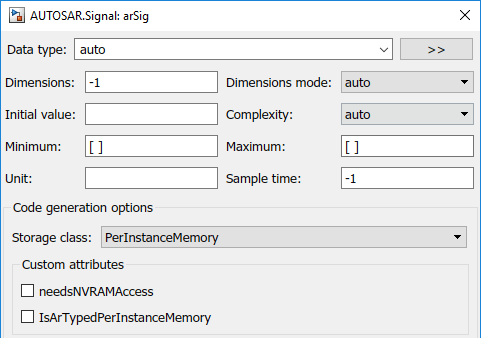AUTOSAR.Signal
Specify data type, code generation options, other attributes of signal
For run-time calibration of AUTOSAR data, R2018b and R2019a introduced graphical mapping of model elements to AUTOSAR component parameters and variables. In the Code Mappings editor, you select a Simulink® model-workspace parameter or internal signal, state, or data store. You map the selected element to an AUTOSAR component parameter or variable and modify its AUTOSAR calibration attributes. If you currently model AUTOSAR parameters or variables by using AUTOSAR parameter or signal objects in the base workspace, consider migrating to the Code Mappings editor workflow. For more information, see Map AUTOSAR Elements for Code Generation.
Description
With this class, you can create workspace objects for modeling per-instance
memory for AUTOSAR runnables. You can create an AUTOSAR.Signal object in
the base MATLAB® workspace.
This class extends the Simulink.Signal class. With signal objects, you
can assign or validate the attributes of a signal or discrete state, such as its data type,
numeric type, dimensions, and so on. For more information, see the Simulink.Signal reference page.
Creation
Create an AUTOSAR.Signal object by using the
AUTOSAR.Signal function described below.
Description
signalObj = AUTOSAR.Signal returns an
AUTOSAR.Signal object with default property values.
Open the workspace object to view and modify its properties.

The Simulink.Signal reference page describes the
signal attributes in detail. The AUTOSAR.Signal class extends the
Simulink.Signal class with the following additional selection for the
Storage class attribute:
PerInstanceMemory— AUTOSAR per-instance memory is instance-specific global memory within an AUTOSAR software component. An AUTOSAR run-time environment generator allocates this memory and provides an API through which you access this memory. Selecting this storage class enables the custom attributes needsNVRAMAccess and IsArTypedPerInstanceMemory.needsNVRAMAccess allows you to specify whether the AUTOSAR signal needs access to nonvolatile RAM on a processor. Depending on the AUTOSAR schema selected for your model, this setting potentially impacts the XML output for your model.
IsArTypedPerInstanceMemory allows you to specify whether to use AUTOSAR-typed per-instance memory rather than C-typed per-instance memory.
After you create an AUTOSAR.Signal object, you can reference it in
a Data Store Memory block.
Version History
Introduced in R2013b